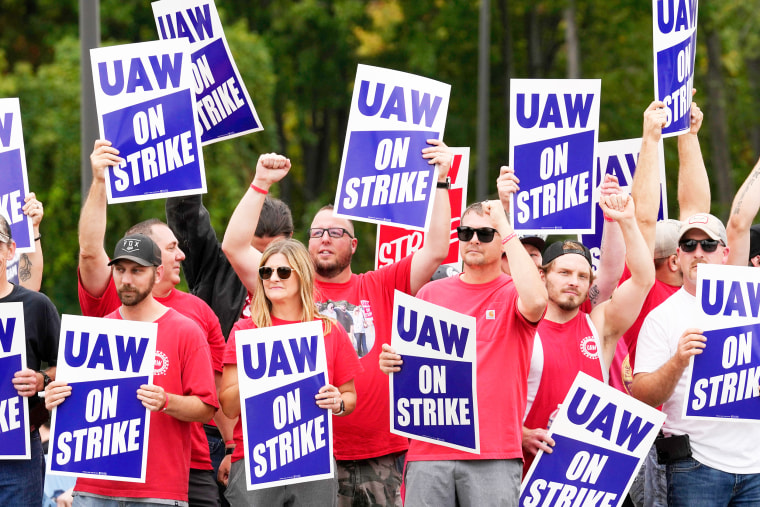The United Auto Workers strike is set to end as the union and General Motors announced a tentative agreement on a new contract Monday.
The breakthrough comes just days after similar deals with Ford and Stellantis.
The union announced a framework agreement with Ford on Wednesday, followed Saturday by a deal with Stellantis, which makes Ram, Dodge and Chrysler vehicles.

The pacts must be approved by local UAW leaders and then ratified by a simple majority of each automaker’s union-represented workers. That process will take several days.
About 13,000 UAW members went on strike Sept. 15, following the expiration of their previous contract with the Big Three. That gradually expanded to about 40,000 of the union's 146,000 members walking off the job. That slowed production for each company, with the effects ramping up over time.
GM said Tuesday that the strike would reduce its annual pretax profit by $800 million and that it was costing it $200 million per week at the time.
If members approve the contracts, they will last 4½ years, through April 30, 2028. Union members will get an 11% initial wage increase and a pay bump of 25% over the course of the deal. The new contract also reinstates cost-of-living adjustments, lets workers reach top wages in three years instead of eight, and protects workers' right to strike over plant closures, among other significantly enhanced benefits.
UAW members agreed to give up on cost-of-living adjustments in the wake of the 2007-08 Great Recession, which forced GM and Chrysler to accept government bailouts followed by corporate restructuring.
That became a major point of contention in the current talks, with UAW President Shawn Fain saying the automakers were making record profits while their employees struggled with reduced benefits for retirees, lower pay for newer hires and the effects of the worst inflation in 40 years.
The result of the talks was a far larger pay increase than the UAW's members had received in the past. The union said the agreement also includes five payments of $500 to union retirees and surviving spouses of union members.
"Record profits mean record contracts," Fain often said.
In leading his first strike as president, Fain spoke about fighting back against "corporate greed" after workers sacrificed to help the car companies survive. That helped cast the strike in political terms. Seeking to bolster his credentials with workers, President Joe Biden accepted Fain's invitation and joined a picket line early in the strike. He was the first sitting president to do so.
Other prominent politicians, especially Democrats, also voiced their support.
It was the first time UAW members had gone on strike simultaneously at all three companies. In the past, the union had struck at one company to force it to the bargaining table and then pushed the two other leading automakers to accept similar terms.
The tactic of starting with a limited strike and gradually expanding was unconventional, as well. Fain, who became president of the autoworkers' union in March, said it was inspired by the union's "sit down strike" against GM almost 90 years ago.
Fain told specific groups of employees to go on strike with little notice, which made it hard for the auto makers to prepare for the union's actions and had an outsize impact relative to the size of the strike even as most UAW members kept going to work. Workers walked off the job at GM, Ford, and Stellantis' profitable truck and SUV plants not at the beginning of the strike, but closer to its end.
The transition to electric vehicles and away from internal combustion engines was also a key area of dispute, as the union accused the Big Three of intending to move jobs out of unionized manufacturing plants and into lower-wage facilities where batteries are made.
The union says GM agreed that the new contract will include people who work at those electric battery plants, as well as workers at GM Subsystems.
The tentative agreement means GM employees will go back to work, as Ford and Stellantis staffers did after those agreements were announced.
CORRECTION (Oct. 30, 2023, 10 p.m. ET): A previous version of this article misstated how long the contracts would last if UAW members approve them. They would last until April 30, 2028, not April 30, 2024.
